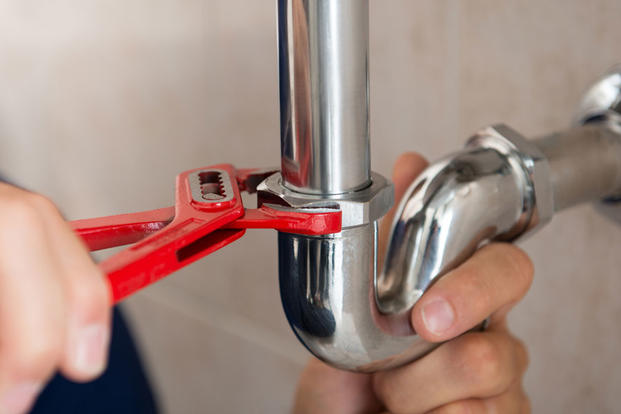Most of us don’t spend a lot of time thinking about our home’s plumbing system. We open a faucet, take a shower, or flush a toilet without much thought—or understanding—about how it all works. And that’s unfortunate, because modern plumbing systems are ingeniously designed and remarkably reliable, and knowing how they operate can help you repair, maintain and upgrade the system, as necessary.
Here, we’ll take a detailed look at the key components that make up a residential plumbing system, including both the water-supply side and the wastewater drainage side. The first thing you need to know is that plumbing systems follow a simple law of nature: Gravity and pressure cause water to seek its own level.
Water In
There are two basic ways that fresh water can enter a home: through a water-main pipe provided by the city, or via a private deep-well pump. In each scenario, water is delivered under sufficient pressure to flow upstairs and around corners to reach each and every fixture in your home.
If you have city water, water passes through a meter and you’re billed each month based on how much water you use. Well systems don’t require a meter—the homeowner doesn’t pay for water and is instead responsible for maintaining the well pump and pressure tank.
Building codes require that a water shut-off valve be installed at the point of entry. For city water, the valve is usually right next to the meter. For a deep-well system, the valve is located where the water-supply pipe exits the pressure tank. It’s critically important that everyone in the family knows where the shut-off valve is located, and how to close it in case of a burst pipe or other emergency. In fact, it’s a good idea to open and close the valve two or three times a year to ensure it’s working properly and hasn’t seized up due to rust, corrosion or mineral deposits.
Note that a point-of-entry valve shuts off water to the entire house. However, there are also individual valves located at fixtures throughout the house, including sink faucets, toilets and washing machines. These valves, known as point-of-use valves, allow you to shut off the water to one fixture without interrupting the water flow to all others.
Once inside the house, the water-supply pipe is divided into two circuits: one for cold water, one for hot. The hot-water supply pipe runs to a water heater or boiler, and then to each fixture that requires hot water. The cold-water supply pipe typically runs alongside the hot-water line, and again, is plumbed to each fixture requiring cold water.
If your home has hot-water baseboards or hydronic radiant-floor heat, then hot-water supply pipes also connect to the heating system, which is controlled by adjustable thermostats. These are closed-loop systems, meaning that water is continuously circulated throughout the system and doesn’t get flushed down a drain.
So, now that we know how water enters your home, let’s take a look at how it exits.
Water Out
As with the water-supply side, there are two basic ways that water exits your home. If you live in a city, you’re likely connected to the municipal sewage system, which is a series of interconnected drainpipes that run under the streets. When you drain a tub or flush a toilet, wastewater flows out of your home’s sewer-main pipe, into the larger buried sewer pipes, and eventually to a sewage treatment plant.
If you live in a town without city sewers, then you likely have a private septic system. Each system is specifically engineered for the house and is sized and designed based on the number of bedrooms and the drainage properties of the soil. Here’s a brief explanation of how a septic system works:
Wastewater leaves the home and flows into a large concrete or plastic septic tank that’s buried on the property. Extending from the tank are leach fields, which are essentially long, underground trenches, lined with perforated pipes and gravel. In the center of the septic tank is a baffle (vertical barrier) that separates liquid waste from solid waste. The liquid eventually drains out of the tank and into the leach fields, where impurities are removed and clean water percolates down into the soil. Solid waste remains trapped inside the septic tank and must be pumped out every few years by a licensed septic contractor.
The interesting aspect of both drainage systems—city sewer and septic—is that neither requires any sort of mechanical help in draining wastewater from your home. Both systems rely on gravity and drainpipes that pitch—or slant—down away from the house.
However, no drainage system would function properly without vent stacks. Vent stacks, also called soil stacks, are simply vertical pipes that extend through the roof to the outdoors. To understand why vent stacks are important, you only need to consider this child’s drinking straw trick: Place the straw in a glass of water, put your finger on top of the straw, then lift it out of the glass. Notice that the water stays trapped in the straw, defying gravity. However, if you lift your finger, gravity takes affect and the water drains out. That’s precisely why vent stacks are necessary: Without them, wastewater would become trapped within the drainpipes.
The final critical components to the drainage system are plumbing traps. A trap is simply a U- or S-shaped pipe that connects to the drain beneath sinks, tubs, showers and other fixtures.
Here’s how a trap works: When water is drained from the fixture, gravity provides sufficient pressure to force the water down the drainpipe. However, a small amount of water remains in the bottom of the trap, where it effectively blocks noxious sewer gasses from entering the house. It’s important to note that the building code requires traps on all necessary fixtures.
Applying Your Knowledge
Now that you have a basic understanding of plumbing systems and components, you are equipped with the first step in troubleshooting plumbing problems, making repairs, maintaining and upgrading fixtures, and talking knowledgeably to professional plumbers. Just be sure to inspect all exposed plumbing components at least twice a year. It’s the very best way to detect small problems before they get worse and cause serious damage.
Joe Truini is a home improvement expert who writes about a variety of topics related to carpentry and plumbing. Joe is also the author of numerous DIY books, including the best-selling Building a Shed. He also writes for The Home Depot, where you will find a large selection of water heaters like the ones Joe describes.




